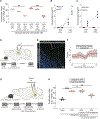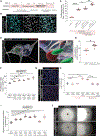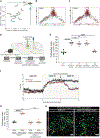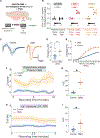Cholinergic neuronal activity promotes diffuse midline glioma growth through muscarinic signaling
- PMID: 40541184
- PMCID: PMC12396346
- DOI: 10.1016/j.cell.2025.05.031
Cholinergic neuronal activity promotes diffuse midline glioma growth through muscarinic signaling
Abstract
Glutamatergic neuronal activity promotes proliferation of both oligodendrocyte precursor cells (OPCs) and gliomas, including diffuse midline glioma (DMG). However, the role of neuromodulatory brainstem neurons projecting to midline structures where DMGs arise remains unexplored. Here, we demonstrate that midbrain cholinergic neuronal activity modulates OPC and DMG proliferation in a circuit-dependent manner. Optogenetic stimulation of the cholinergic pedunculopontine nucleus (PPN) promotes glioma growth in pons, while stimulation of the laterodorsal tegmentum nucleus (LDT) drives proliferation in thalamus. DMG-bearing mice exhibit higher acetylcholine release and increased cholinergic neuronal activity over the disease course. In co-culture, cholinergic neurons enhance DMG proliferation, and acetylcholine directly acts on DMG cells. Single-cell RNA sequencing revealed high CHRM1 and CHRM3 expression in primary DMG samples. Pharmacological or genetic blockade of M1/M3 receptors abolished cholinergic activity-driven DMG proliferation. Taken together, these findings demonstrate that midbrain cholinergic long-range projections promote activity-dependent DMG growth, mirroring a parallel proliferative effect on healthy OPCs.
Keywords: DMG; LDT; OPC; PPN; cholinergic neuron; diffuse midline glioma; glioma; laterodorsal tegmentum nucleus; neuron; neuron-glioma; neuronal activity; oligodendrocyte; oligodendrogenesis; pedunculopontine nucleus.
Copyright © 2025 The Author(s). Published by Elsevier Inc. All rights reserved.
Conflict of interest statement
Declaration of interests M.M. and K.D. hold equity in Maplight Therapeutics and Stellaromics. K.D. is a founder and consultant for MapLight Therapeutics and Stellaromics. R.D., A.D., A.G., K.D., and M.M. are inventors on a patent application for treating central nervous system tumors using muscarinic receptor antagonists. K.D. is a consultant for Modulight.bio and RedTree.
Figures






Update of
-
Cholinergic Neuronal Activity Promotes Diffuse Midline Glioma Growth through Muscarinic Signaling.bioRxiv [Preprint]. 2024 Sep 24:2024.09.21.614235. doi: 10.1101/2024.09.21.614235. bioRxiv. 2024. Update in: Cell. 2025 Aug 21;188(17):4640-4657.e30. doi: 10.1016/j.cell.2025.05.031. PMID: 39386427 Free PMC article. Updated. Preprint.
References
MeSH terms
Substances
Grants and funding
LinkOut - more resources
Full Text Sources
Medical
Molecular Biology Databases
Research Materials

